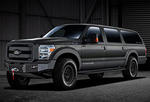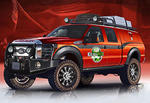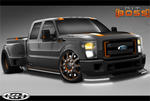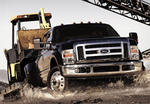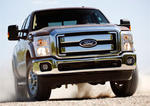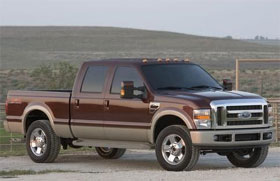
Ford described the ten tests that the 2008 Ford F-Series Super Duty had to go through in order to ensure quality, durability and dependability. Ford says that in testing the 2008 Ford F-Series Super Duty traveled 10 milion miles in the most extreme conditions possible.
Ford Press Release:
TEN TORTURE TESTS FROM FORD
The definition of “Built Ford Tough” is rooted in a series of grueling tests designed to ensure quality, durability and dependability. Even before the all-new 2008 Ford F-Series Super Duty reached dealerships early this year, prototypes
of America’s favorite work truck logged more than 10 million miles of testing in all kinds of conditions – including nearly 3 million miles of real-world customer durability testing in some of the most extreme conditions possible.
From the bitter cold of the Arctic to the blazing heat of the Arizona desert, Ford’s real-world testing for all its vehicles covers a gauntlet of demanding procedures conducted in torturous terrain. It’s complemented by a battery of lab-based tests designed to induce more damage than
the toughest customer can dole out. Below are just a few examples of the wide range of punishing and unconventional tests developed to prove out the durability and capability of Ford, Lincoln and Mercury vehicles.
Open-and-Shut Case – If it’s on a car and it opens and closes, it undergoes rigorous testing at Ford that equates to roughly 10 years of average use. Ford’s Body Testing engineers load test vehicles into a mechanical fixture designed to replicate human use. For example, to test a door: A hydraulic arm reaches down, lifts the hatch, opens the door, then closes
it – 84,000 times. The testing cycle also includes rolling the window up and down and locking and unlocking the doors 26,000 times. Decklids are tested to 10,000 cycles, liftgates to 25,000 cycles and hoods to 1,500. Even fuel doors are tested – opened and closed 3,000 times. Each test is performed in a sealed climactic chamber, with tests run at temperatures varying from -40 ° F to +180 ° F. Tests typically last 4-6 weeks, depending on the complexity. If closures don’t meet the standards set by Ford, they’re sent back to engineering for improvement.
Surviving Silver Creek – Ford’s famed Silver Creek test was developed in 1977 to simulate an actual off-road trail in Northern Arizona known for its severity. This man-made surface at the company’s Arizona Proving Grounds was constructed to capture the loads and damage for durability testing. Silver Creek combines two extremely rough roads – one section has 15 distinct types of bumps and chuckholes while the other is made from broken concrete pieces in a random matrix. Traveling a mere 2,000 feet on this course is the equivalent to approximately 20 miles of the original severe off-road surface.
Snaking Through the Sand Wash – A deep bed of loose sand is used to test steering systems and four-wheel-/ all-wheel-drive components on
Ford, Lincoln and Mercury vehicles. It is targeted to meet the demands of customers who use their vehicles on construction sites, as well as recreational use on beaches and sand dunes. During each test event, Ford engineers tackle the 8-inch-deep sand surface driving two miles in a serpentine formation.
Chuckholes – Taking the Hit – To give drivers a fighting chance against wheel and tire damage caused by less-than-perfect roads, Ford engineers have designed suspension parts to handle chuckholes as effectively as possible. Engineers tune shock rebound rates to keep wheels and tires suspended so they can glide over potholes instead of dropping down into them. To approximate the most severe conditions a Midwest customer might encounter, Ford engineers have devised a durability test consisting of a series of 4-inch deep square-edge chuckholes with a width of up to 30 inches. A complete test sequence includes approximately 2,700 chuckhole hits for each wheel.
Performing in a Deep Freeze – Ford engineers have significantly improved engine cylinder head and head gasket design, thanks in part to a brutal Deep Thermal Shock test conducted at the company’s Engine Laboratory in Dearborn, Mich. This abusive cold start test runs to failure or for 150 hours – whichever comes first. Vehicles withstand -22 ° F shock for 300 cycles, going through repeated heating-to-cooling cycles. Meanwhile, engineers at the Automatic Transmission Development Laboratory in Livonia, Mich., freeze vehicle parts to -60 ° F, then apply maximum torsional loads. This Deep Freeze Torsional Fatigue testing is designed to ensure Ford parts survive deep thermal shock for start-ups in cold weather climates.
Wear and Tear – Ford’s Manual Transmission Clutch Wear Test does to your clutch in 30 seconds what it would take your teenager a full year to accomplish. It was developed to ensure that heat generated by excessive clutch wear would not induce mechanical failure. The test, conducted at the Automatic Transmission Development Laboratory, applies continuous slip to a vehicle’s clutch assembly until all material is disintegrated to ensure against support component failure.
Choke Hold – Imagine your heart beating minus the blood flow. To ensure that the transmission pump can survive momentary fluid loss, Ford engineers put vehicles through a speed, temperature and pressure matrix while draining the oil from the pump (choking). The Pump Performance with Max Durability test has vehicles endure speeds as high as 8,000 rpms with temperatures exceeding 250 ° F as their pumps are “bled dry.”
Welcome to Curb Island – Engineers subject Ford, Lincoln and Mercury cars and crossovers to this test inspired by an actual curb in Southeast Michigan. Curb Island simulates an expressway run-off situation in which a vehicle runs into a curb with an entry height of 5 inches and exit height of 5.5 inches at approximately 10 degrees. Approaching the curb at speed induces very high impact loads (strength-based loads) while exiting can induce complete rebound of a vehicle suspension.
Let’s Do the Twist (Ditch) – This lab-based test simulates traversing a deep angled ditch. It’s designed to ensure a vehicle can travel over washouts and across dry river beds. Twist Ditch puts the vehicle in an extreme body twist, inducing torsion by articulating the suspension to support the vehicle weight on only two opposing wheels at a time (left-front/right-rear or right-front/left-rear).
A Sticky Situation – Attention, drivers of cars that fall victim to fruit juice and soda spills: Ford engineers have developed a test for console-mounted shifters designed with the messy in mind. Sticky liquid can collect on the sliders – the small pieces of plastic that move as you shift from park to drive – making it harder to shift or potentially jamming the shifter altogether. Ford has devised a test to ensure all of its shifters are able to survive a dousing from diet cola. A fixture suspends a large cup in a small frame supported at 45 degrees over the shifter. The engineer fills the cup with 12 ounces of soda (the equivalent of one can), pulls a trigger, and the cup drops and sends fluid all over the shifter. The test is repeated 12 times to make sure the design is capable. The tests have driven design changes to help route fluid away from the shifter.
